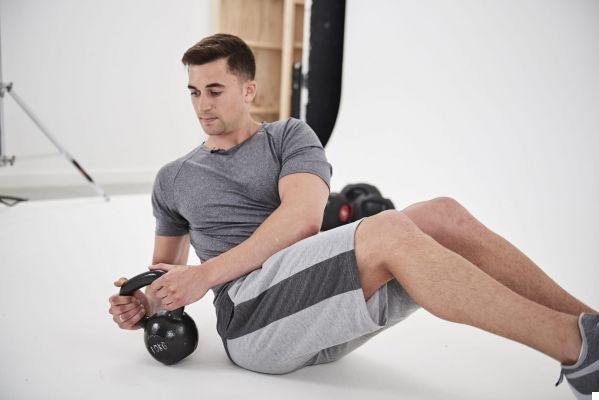By scissoring we mean the exercise in which the abdominals remain contracted in isometry while the lower limbs move alternately up and down or to the right and left. This exercise works well as part of a HIIT or as a final exercise for a mini abs circuit.
Let's see how scissoring can be a useful abdominal workout.
Discover Giulia's workout routine:
Performing the scissor kick
Begin on your back with your hands on your hips. This position, as in the reverse crunch, serves only to counter balance the weight of the lower body and does not act as a direct author of the movement.
- Contract the transverse abdominis and abdominals. It is possible to perform a reverse crunch and descend to the position where the legs are slightly off the ground or simply lift the legs slightly off the ground and that's it. The first option, that is to perform a reverse crunch initially, allows you to feel the contraction of the abdominals more easily and therefore also makes it easier to maintain it, thus leading to a better execution of the exercise.
- Keeping the legs off the ground and the knees extended bring one foot up, while the other remains down, and then switch the position of the two feet. It is also possible to bring one foot to the right and one to the left and then cross them. The first variant allows the rectus abdominis to be more destabilized and therefore increases the isometric work of this muscle. The second variant allows to laterally destabilize the abdomen and therefore to involve more the oblique muscles of the abdomen.
- The movement of the legs must not be exasperated (you must not bring the feet towards the ceiling or open the legs excessively) but you must simply destabilize the position.
- Continue in the scissoring movement until the compression of the abdomen can be maintained.
Muscles involved

The muscles involved are certainly the abdominals and the hip flexors as direct authors of the movement. Great lats and long head of the triceps work to keep the trunk close to the ground.
The abdominals work in isometry so as not to extend the lumbar area while the hip flexors work to keep the legs off the ground.
In the variant in which the scissors take place on a horizontal plane (therefore on the right and left) the obliques also work more to avoid a lateral extension and a rotation given by the moment of the legs.
This variant is therefore more demanding because performing scissors on a vertical plane (therefore up and down) only destabilizes the pelvis with the contraction of the hip flexors and with a reduced vertical moment.
Common mistakes
The scissoring exercise is relatively simple and a common mistake is arching the back. This occurs due to an incorrect activation of the abdominal muscles or a weakness of this.
If it is the first case it is useful to concentrate on keeping the lumbar adherent to the ground while in the second case it is sufficient to slightly flex the knees to reduce the lever arm. Another mistake is to perform excessively large scissors (discussed above).
Progress
Since the scissoring exercise is relatively easy, it may be useful to propose greater difficulties to test yourself and therefore improve. Here are some in order of increasing difficulty:
Scissoring at the bar
Cling to a bar and bring your legs to an "L" position. from here perform vertical or lateral scissors.
In this progression it is important to focus on the retroversion of the pelvis. It is not necessary to simply lift the thighs by extending the lumbar area but it is essential to keep the lumbar area neutral or rather flexed and the pelvis retroverted.
L-sit scissoring
Move to the L-sit position between two parallels. At this point, perform lateral or vertical scissors.
Also in this case it is important to keep the lumbar area neutral or flexed and the pelvis backwards (all while maintaining a correct L-sit).
Scissoring in Dragon Flag
Execute a Dragon Flag and go almost parallel to the ground. Maintaining the abdominal contraction perform scissors (lateral or vertical).
In this progression it is useful to concentrate on the buttocks, which must remain constantly contracted, and on the transverse, trying to pull the belly in for the entire duration of the exercise.
The abdominal contraction should come by itself keeping the pelvis rearward (buttocks contracted).
The second variant is not necessarily easier than the third, since it is a Skill it depends on your personal training repertoire.
The L-sit variant works on maximum compression while the Dragon Flag variant works with longer levers.
Conclusion
Scissoring is a useful and simple exercise for abdominal training. It allows you to strengthen your muscles and make them stronger and more resilient with less physical effort.
Our articles should be used for informational and educational purposes only and are not intended to be taken as medical advice. If you are concerned, consult a health professional before taking dietary supplements or making major changes to your diet.


























